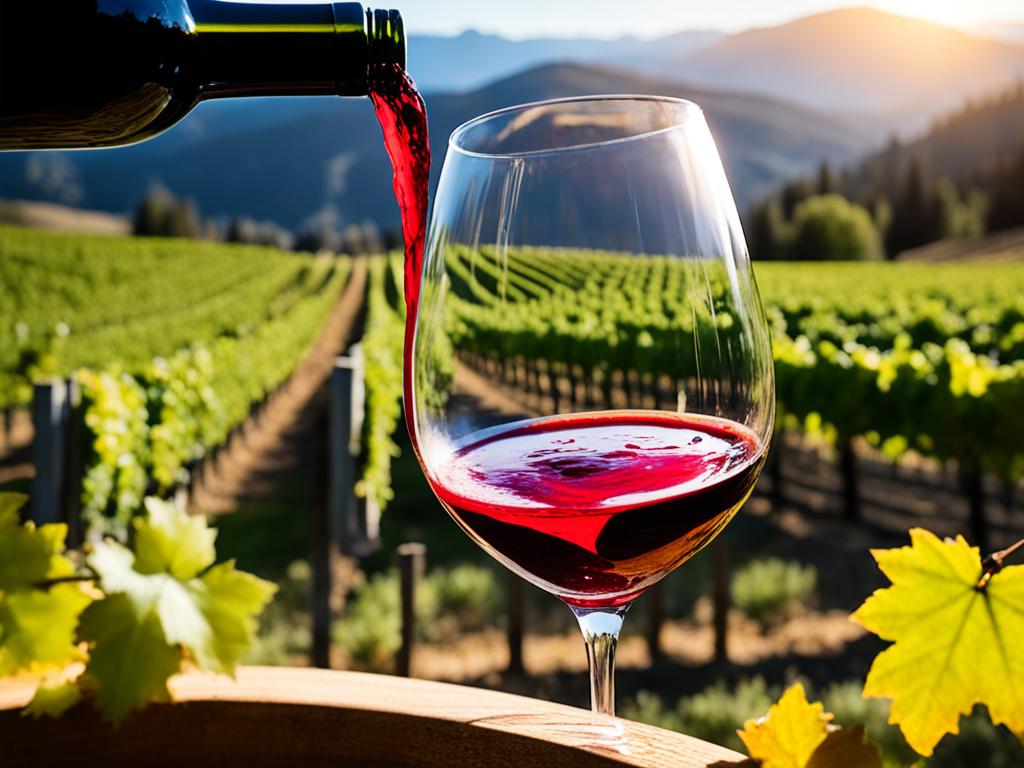Welcome to the world of wine! Whether you’re a novice or a wine enthusiast, understanding the basics is key to unlocking a world of flavors, aromas, and experiences. In this section, we will guide you through the essential aspects of wine, equipping you with the knowledge to select the right bottle, appreciate its nuances, and enjoy it to the fullest.
From grape varietals to wine labels and serving temperatures, we will cover it all. So, grab a glass, sit back, and let’s dive into the wonderful world of wine!
Key Takeaways:
- Understanding the basics of wine is essential for a richer wine experience.
- Mastering wine fundamentals includes selecting the right bottle, understanding wine types and regional differences.
- Decoding wine labels empowers you to make informed decisions when choosing a bottle.
- The right wine accessories and storage techniques enhance your enjoyment of wine.
- Temperature and glassware play a crucial role in serving wine at its best.
Understanding the Basics
When it comes to wine, having a basic understanding of its various aspects is essential in order to truly appreciate its nuances. In this section, we will delve into the foundational knowledge that will enable you to develop a deeper appreciation for this diverse and fascinating beverage.
The Different Types of Wine
Wine comes in a wide variety of types, each with its own unique characteristics and flavors. From red and white to rosé and sparkling, understanding the differences between these types is crucial in selecting a bottle that suits your preferences. Exploring the characteristics of each type allows you to expand your palate and discover new favorites.
Grape Varietals
The type of grape used in winemaking directly influences the taste and aroma of the wine. From familiar grapes like Cabernet Sauvignon and Chardonnay to lesser-known varietals like Gewürztraminer and Sangiovese, familiarizing yourself with the diverse range of grape varietals will enhance your ability to discern and appreciate different wine flavors.
Regional Differences
Wine production is not limited to a single region. Different wine regions around the world have unique climates, soils, and winemaking traditions that result in distinctive flavors and styles. Exploring wines from renowned regions such as Bordeaux, Napa Valley, and Tuscany will allow you to appreciate the regional influences on wine production and gain a deeper understanding of the world of wine.
| Type of Wine | Grape Varietals | Notable Regions |
|---|---|---|
| Red | Merlot, Cabernet Sauvignon, Pinot Noir | Bordeaux (France), Napa Valley (USA) |
| White | Chardonnay, Sauvignon Blanc, Riesling | Burgundy (France), Marlborough (New Zealand) |
| Rosé | Grenache, Syrah, Mourvèdre | Provence (France), Rioja (Spain) |
| Sparkling | Chardonnay, Pinot Noir, Pinot Meunier | Champagne (France), Prosecco (Italy) |
Understanding the basics of wine, from the different types to the grape varietals and regional differences, sets the foundation for your wine journey. Armed with this knowledge, you can confidently explore the intricate world of wine and develop your own preferences.
Next, we will decode the often confusing world of wine labels. Stay tuned to unravel the secrets behind the information presented on wine labels and learn how to make informed decisions when selecting a bottle.
Decoding Wine Labels: A Beginner’s Guide
When you first start exploring the world of wine, you may find yourself puzzled by the labels on the bottles. Fear not, decoding wine labels is easier than you think! In this section, we will demystify the intricacies of wine labels, equipping you with the knowledge to confidently navigate wine selections and make informed choices.
Wine labels contain valuable information about the wine’s origin, grape variety, production methods, and more. To unlock the secrets of these labels, let’s break down the key elements you need to understand:
- Vintage: The vintage refers to the year the grapes were harvested. This information gives you insight into the wine’s age and can affect its flavor profile. Keep in mind that different vintages can vary in quality due to weather conditions and other factors.
- Appellation: The appellation indicates the wine’s geographic origin, whether it’s a specific country, region, or even a single vineyard. Appellations can provide clues about the wine’s style and quality, as certain regions are renowned for producing exceptional wines.
- Grape Varietal: Some wine labels prominently display the grape variety used to make the wine. For example, a label that reads “Chardonnay” indicates the wine is made from Chardonnay grapes. Familiarizing yourself with different grape varietals will help you understand the wine’s flavor profile and characteristics.
- Alcohol Content: The alcohol content is expressed as a percentage on the label, typically ranging from 12% to 15%. This information can give you an idea of the wine’s body and richness.
- Producer: The producer’s name indicates the winery or vineyard responsible for making the wine. Some producers have a long-standing reputation for producing high-quality wines, while others may be lesser-known but equally talented.
By familiarizing yourself with these key elements, you’ll be able to make more informed decisions when selecting a bottle of wine. Don’t be afraid to venture beyond your comfort zone and explore different regions, grape varietals, and vintages to broaden your wine-tasting horizons.
“The discovery of a good wine is increasingly better for mankind than the discovery of a new star.” – Leonardo da Vinci
The Essential Wine Toolkit: Accessories and Storage
When it comes to enjoying wine to its fullest, having the right tools and accessories is essential. Whether you’re a wine enthusiast or a casual drinker, investing in the proper equipment can enhance your overall wine experience. From opening the bottle to storing it for future enjoyment, here is everything you need to know about the essential wine toolkit, accessories, and storage.
Corkscrews: Opening Bottles with Ease
Every wine lover needs a reliable corkscrew to effortlessly open bottles. Look for a sturdy and ergonomic design that allows for a smooth extraction without damaging the cork. Popular options include the classic waiter’s corkscrew with a foldable design for easy portability and the sleek and efficient lever-style corkscrew. Whichever style you choose, a quality corkscrew ensures that the wine is not compromised during the opening process.
Decanters: Enhancing the Flavor
To fully experience the flavors and aromas of certain wines, decanting is key. A decanter not only adds an elegant touch to your wine presentation but also helps aerate the wine, allowing it to reach its full potential. Choose a decanter with a wide base and a long neck to provide ample oxygenation. The process of decanting can vary depending on the type of wine, so be sure to research the recommended decanting time for each bottle.
Wine Racks: Organizing and Displaying
A wine rack serves two purposes: it keeps your bottles organized and showcases your collection. Whether you opt for a compact countertop rack or a floor-standing one, consider the size of your collection and the available space in your home. Look for a sturdy and well-constructed rack made from materials like wood or metal to ensure that your wine bottles are safely stored. Additionally, wine racks can be designed to fit seamlessly into your existing décor, adding a touch of elegance to your space.
Refrigeration: Preserving the Quality
Proper storage temperature is crucial for preserving the quality of your wine. Investing in a wine refrigerator or cooler ensures that your bottles are kept at the optimal temperature, protecting them from heat, light, and temperature fluctuations. Look for a unit that offers adjustable temperature controls and UV protection to maintain the ideal storage conditions. Whether you’re a collector or enjoy the occasional bottle, refrigeration is an essential component of wine storage.
By equipping yourself with the essential wine toolkit, you can elevate your overall wine experience. From effortlessly opening bottles with a reliable corkscrew to enhancing the flavor through decanting and properly storing your collection, the right tools and accessories make all the difference. Cheers to enjoying wine to its fullest!
Serving Wine: Temperature and Glassware
When it comes to serving wine, the temperature and glassware you choose can significantly impact your overall enjoyment and appreciation of the flavors and aromas. Serving wine at the proper temperature allows the characteristics of the wine to shine, while selecting the right glassware enhances its visual appeal and aroma.
The Optimal Serving Temperature
Each type of wine has an optimal serving temperature that brings out its unique qualities. Serving wine too warm or too cold can alter its taste and diminish your experience. As a general rule:
- Serve sparkling wines, such as Champagne or Prosecco, chilled between 40°F and 50°F (4°C and 10°C) to preserve their effervescence and freshness.
- White wines are best served between 45°F and 55°F (7°C and 13°C) to highlight their fruitiness and acidity.
- Light-bodied red wines, like Pinot Noir, are enjoyable when served slightly chilled between 50°F and 60°F (10°C and 15°C) to emphasize their delicate flavors.
- Full-bodied red wines, such as Cabernet Sauvignon and Syrah, are best served between 60°F and 65°F (15°C and 18°C) to enhance their complex aromas and smooth tannins.
Remember that these are general guidelines, and personal preference should also be considered. Adjust the serving temperature based on your taste preferences and the specific characteristics of the wine.
The Importance of Glassware
Choosing the right glassware for your wine can significantly enhance your drinking experience. The shape and design of the glass can affect how the wine is presented to your senses, including its aroma, flavor, and overall balance.
“The right wine glass can elevate your wine-drinking experience by allowing the wine to fully express its unique characteristics.” – Wine connoisseur, Jane Adams
When selecting glassware:
- Opt for clear, thin glass, as it allows you to appreciate the color and clarity of the wine.
- Use glasses with a narrow rim for white wines. This helps focus the aromas towards your nose, enhancing the overall scent.
- For red wines, choose glasses with a wider bowl and larger opening. This allows the wine to come into contact with more air, releasing its complex aromas and flavors.
- Consider investing in varietal-specific glassware, designed to enhance the unique characteristics of different grape varieties.
By selecting the appropriate glassware, you can fully savor the nuances of each wine and appreciate its true potential.
| Wine Type | Optimal Serving Temperature (°F) |
|---|---|
| Sparkling Wine | 40°F – 50°F |
| White Wine | 45°F – 55°F |
| Light-Bodied Red Wine | 50°F – 60°F |
| Full-Bodied Red Wine | 60°F – 65°F |
Remember, serving wine at the correct temperature and in suitable glassware enriches your wine experience, allowing you to fully appreciate the aromas, flavors, and complexities of each bottle. Cheers to a well-served glass of wine!
Conclusion
Congratulations on completing your journey through the wine basics! You have now mastered the fundamentals of wine, equipping yourself with the knowledge and confidence to make informed choices when it comes to wine selection, tasting, and enjoyment.
By understanding the different types of wine, decoding wine labels, and learning about serving temperatures and glassware, you have gained valuable insights into the fascinating world of wine. Armed with this knowledge, you can now navigate wine lists with ease, confidently select bottles that suit your preferences, and savor each sip to the fullest.
Remember, wine is a rich and diverse beverage that constantly offers new experiences. As you continue your wine journey, don’t be afraid to explore different regions, grape varietals, and styles. The more you taste and learn, the deeper your appreciation for wine will become.
So, raise a glass and toast to your newfound wine expertise. Whether you’re celebrating a special occasion or simply enjoying a quiet evening, let the wine basics guide you towards memorable moments and a deeper enjoyment of this timeless elixir. Cheers!







